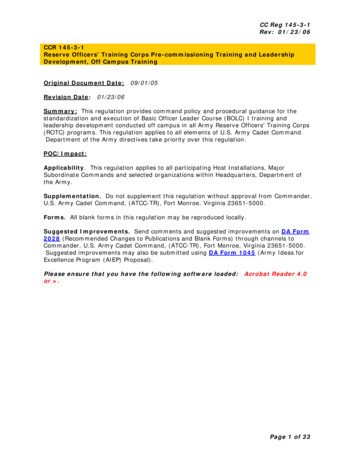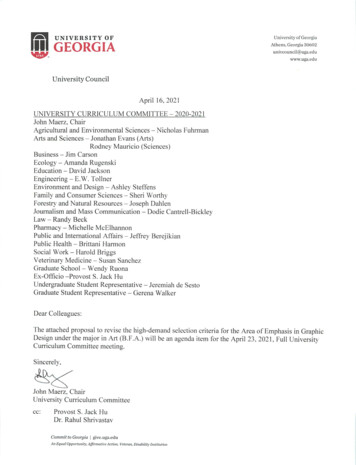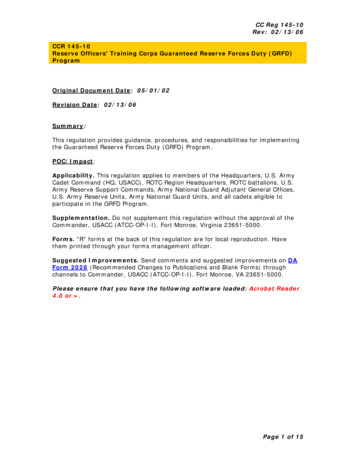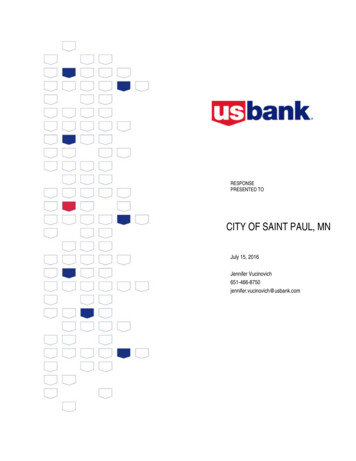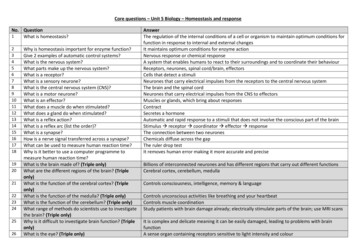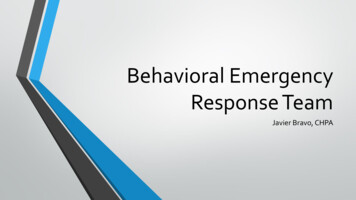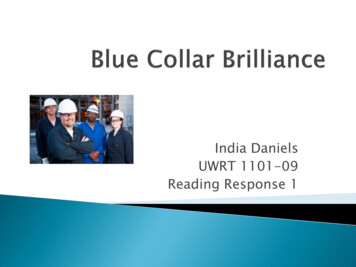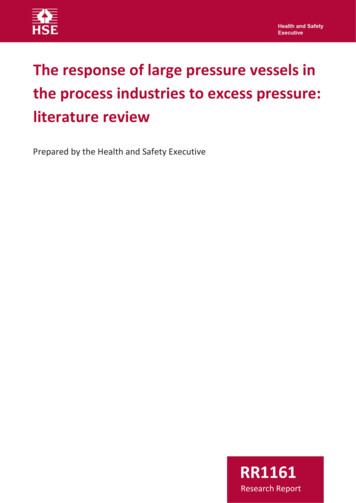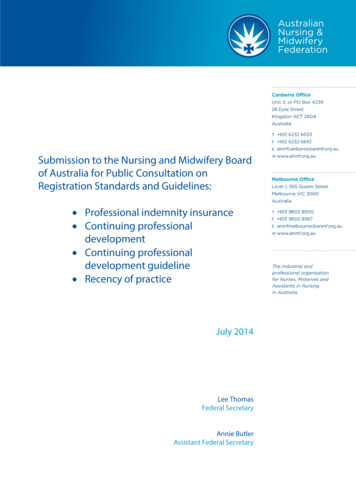
Transcription
Submission to the Nursing and Midwifery Boardof Australia for Public Consultation onRegistration Standards and Guidelines: Professional indemnity insurance Continuing professionaldevelopment Continuing professionaldevelopment guideline Recency of practiceJuly 2014Lee ThomasFederal SecretaryAnnie ButlerAssistant Federal Secretary
IntroductionEstablished in 1924, the Australian Nursing and Midwifery Federation (ANMF) is the largestprofessional and industrial organisation in Australia for nurses and midwives, with Branchesin each State and Territory of Australia. The core business of the ANMF is the professionaland industrial representation of our members and the professions of nursing and midwifery.With a membership of over 240,000 nurses, midwives and assistants in nursing, ourmembers are employed in a wide range of enterprises in urban, rural and remote locations inboth the public and private health and aged care sectors.The ANMF takes a leadership role for the nursing and midwifery professions by participatingin the development of policy relating to: nursing and midwifery practice, professionalism,regulation, education, training, workforce, and socio-economic welfare; health and aged care,community services, veterans’ affairs, workplace health and safety, industrial relations, socialjustice, human rights, immigration, foreign affairs and law reform.Our organisation has a long standing interest in, and have participated in the development of,the suite of Nursing and Midwifery Board of Australia (NMBA) registration standards. TheANMF promotes safe, competent practice by nurses and midwives, maintaining thatregistration standards governing this practice must be both fair and equitable to healthprofessionals and serve to protection of the public.We have perused the NMBA consultation paper issued by the NMBA containing proposedoptions in the review of the registration standards and guideline below: Professional indemnity insurance Continuing professional development Continuing professional development guideline Recency of practiceThe ANMF submits the following feedback to strengthen clarity and usefulness of theregistration standards and guidelines for nurses and midwives.Review of Professional indemnity insurance registration standardOpening comment:In our submission to the 2011 revision of the Professional indemnity insurance (PII)arrangements registration standard we stated our distinct understanding that whileemployers provide vicarious liability cover they do not usually provide PII cover. Direct2
reference to the employer providing PII cover was then removed from the 2012 registrationstandard, and it is pleasing to note this inference does not appear in the 2014 revisedregistration draft standard. However, the Guidelines for professional indemnity insurancearrangements for midwives (2013) still carries the wording in Figure 1 (page 2): Employerusually provides PII coverage for employees. The ANMF requests the NMBA takes theopportunity of this review process to amend that wording to: Employer may provide PIIcoverage for employees. Nurses and midwives should not be misled about the provision ofPII cover by employers.An example of the foregoing was provided to us by our Queensland State Branch. TheirGovernment has made recent changes to introduce a blanket indemnity policy which coversall categories of employees in the health sector, rather than one specific to healthprofessionals. The Australian Health Practitioner Regulation Agency (AHPRA) has indicatedthe changes to the indemnity policy technically meet the NMBA registration standard byensuring indemnity for acts or omissions made in good faith. However, AHPRA has qualifiedthis statement by adding that the individual nurse or midwife may not be fully covered forpersonal liability.The registration standard should provide clarity for nurses and midwives on this issue. Weconsider, in addition to its legislated duties under the National Law, the NMBA has a moralduty to protect nurses and midwives from misinformation regarding matters that, without anin-depth understanding of the nuances of indemnity law and insurance, could potentiallydestroy an individual nurse or midwife’s financial future.The ANMF position remains consistent in that an employer’s indemnity policy which isconditional upon the nurse or midwife acting without gross negligence will not provideappropriate and full indemnity to the practitioner. We note the registration standard clearlystates there must be insurance against civil liability incurred as a result of a negligent act.Gross negligence is still negligence, so it is difficult to understand how State or Territorygovernment indemnity policy meets the registration standard if it does not provide indemnityfor gross negligence.Options statement:The ANMF supports Option 2 – a revised Professional indemnity insurance registrationstandard.3
Feedback against the NMBA questions for considerationThe ANMF provides the following feedback on the questions posed by the NMBA’s publicconsultation paper on Review of Professional indemnity insurance registration standard.1.From your perspective, how is the current registration standard working?Members of the ANMF have not experienced difficulties in complying with the currentregistration standard due to their PII coverage within their ANMF membership. Given ourinsurance arrangement has been chosen because it meets the requirements set by theNMBA, our members covered by this PII know they will meet the registration standard ifaudited.However, non-members have expressed to ANMF officials they are unsure how theiremployer’s indemnity protects them, except that the employer has told them they arecovered and that they meet the NMBA registration standard. These nurses and midwiveshave reported difficulty obtaining written evidence of PII cover from their employers andremain unsure of the format evidence should take in order to meet NMBA auditrequirements.2.Is the content of the draft revised registration standard helpful, clear, relevantand more workable than the current standard?Generally, the language of the new headings is much clearer and more helpful to the reader.The layout and language throughout the draft registration standard is also easier tounderstand.Of concern, however, is that the wording of the current standard in Requirement 3: “ Thefollowing PII cover should be considered ” has now become in the revised standard: “YourPII cover must include ” That is, the revised standard seems to demand an imperativerather than a standard with exceptions. The ANMF reiterates commentary previouslysupplied to the NMBA in relation to the PII registration standard and the level ofunderstanding required of nurses and midwives:It is the view of the ANF that the proposed Standard places an obligation uponnurses and midwives to make an assessment [about the nature of the PIIcover] which they may not be equipped to make. In many States andTerritories the legal profession does not place the onus upon lawyers andbarristers to make such complex assessment as to what constitutes insurance‘arrangements’ appropriate to their practice, it designates approved insurance4
providers. If the legal profession has determined lawyers should not make theirown assessments, the question must be asked, why the NMBA thinks thatnurses and midwives are any better equipped to do so. The ANF contends thatthis may lead to many nurses and midwives under insuring [and inadvertentlybreaching the registration standard]. The consequence of this would underminethe public policy objective of the Standard and the objective in Section 129 ofthe National Law.The ANMF submits that the requirement by the NMBA that every nurse or midwife assessand understand their level of cover is unreasonable and impractical. As stated above, despitean experienced legal practitioner being in a position to understand indemnity insurance, theregulation of the legal profession does not place the onus upon them to do so. Instead thelegal profession advantages itself of indemnity law experts and consequently designatesapproved insurance providers that provide appropriate indemnity cover, for both thepractitioner and the public. We believe the NMBA should follow suit and protect nurses andmidwives, and the public, in similar fashion.3.Is there any content that needs to be changed or deleted in the revised draftregistration standard?Yes, as follows: The wording of the first sentence under Does this standard apply to me? reads as if the‘non-practising registration’ applies only to eligible midwives. Suggested word change:This standard applies to all enrolled nurses, registered nurses, nursepractitioners, midwives and eligible midwives, except those nurses andmidwives with non-practising registration. The section referring to the PII arrangements guideline documents needs to be positionedcloser to the start of the registration standard so that the reader is aware of this additionalinformation as they read through the standard. Also, a web address and link to thedocuments on the NMBA website would aid in accessibility. Under the section What I must do? Point 2 (e) page 7, while there is a definition for ‘Third party cover’ to includeinsurance through an employer the reference to ‘self-insurance by publicsector employers’ is not defined – it is unclear if this is referring to the samecover (Third party cover) and if so the language should be consistentthroughout the document. Point 3. page 8, reference the last sentence “should any area of your practicespecifically be precluded from your third party PII arrangement, you must not5
practice in that area”. Clarification is sought as to whether this statementapplies to all manner of insurance – not just third party. In addition the use ofthe word “area” is perhaps not the best descriptor - does this moreappropriately refer to ‘specific activities’ rather than ‘area of practice’? Point 4 page 8, is confusing and requires re-wording for clarity. It should bebroken down as dot points of its component parts, as follows:If your PII arrangements are provided by your employer, then youmust have individual PII arrangements in place if you intend to:opractice outside your stated employment;opractice as a volunteer (unless you are already or separately coveredin that capacity, for example by the volunteering organisation);oundertake practical components of continuing professionaldevelopment. Under the section ‘Amount of cover’, reference clause (h) - “any advice froman insurance broker or insurer”. This would appear to be included in clause (g)“any advice from professional indemnity insurers, professional associations ”If the NMBA intends that this point be quite different then this intent needs tobe spelt out more clearly.4.Is there anything missing that needs to be added to the revised draftregistration standard?Under the headings PII arrangements guideline for enrolled nurses, registered nurses andnurse practitioners and PII arrangements guideline for registered midwives it would be usefulto have a link to the Guidelines document on the NMBA website and/or the web address, forease of access.Under the ‘Definitions’ section (page 10) there is a definition for ‘Nurse’ but not for ‘Midwife’.5.Do you have any other comments on the revised registration draft standard?With reference to the review period for the registration standard the ANMF considers themost appropriate period to be three years. Given changes which may occur within thenursing and midwifery professions, the health and aged care sectors and the broader publicand political spheres, this period of review would allow for continuous improvement of thestandard. In addition, information gained through the annual auditing of nurses and midwives(via random sampling selection) will provide valuable evidence for necessary changes.6
This three yearly review process applies to the review of all other NMBA registrationstandards for nurses and midwives.Review of Continuing professional development registration standardOpening comment:In point 26 under Summary of issue there is mention of a commissioned review of literatureto ascertain if there was any available evidence regarding the effectiveness of continuingprofessional development (CPD). The reference for this systematic review is then cited at theend of the Guideline: continuing professional development document. The document is citedas Tivey, D. Tufanaru, C. Munn, Z. Riitano, D. Aromataris, E. Pearson, A. 2012. ContinuingProfessional Development to maintain competency and achieve improvements in practice: asystematic review. prepared by The Joanna Briggs Institute, Faculty of Health Sciences, TheUniversity of Adelaide for the Australian Health Practitioner Regulation Agency.The ANMF was interested to read this systematic review but have found that it is not publiclyavailable. While the Australian Health Practitioner Regulation Agency (AHPRA) may havereasons for not allowing public access to this document, the fact that it is not accessibleshould be transparent to the reader. This includes both a note in the public consultationpaper when the review is first mentioned, and, a statement at the end of the citation, in theGuideline, to the effect that the systematic review is not accessible to the public.Options statement:The ANMF supports Option 2 – a revised registration standard for Continuing professionaldevelopment.Feedback against the NMBA questions for considerationThe ANMF provides the following feedback on the questions posed by the NMBA’s publicconsultation paper on Review of Continuing professional development registration standard.1.From your perspective, how is the current registration standardworking?The ANMF is not aware of any difficulties experienced by nurses and midwives in meetingthe Continuing professional development registration standard. It has been reported thatthere has been a lack of clarity in relation to mandatory training and whether all componentscan be included as evidence in an annual record. This appears to have been addressed in7
the revised guideline. However, this clarification should also be added to the revisedregistration standard.2.Is the content of the draft revised registration standard helpful, clear,relevant and more workable than the current standard?Yes, as follows: The language of the new headings is much clearer and more helpful to the reader. Thelayout and language throughout the draft registration standard is also easier tounderstand. Providing a separate registration standard on continuing professional development (CPD)for nurses and midwives gives greater clarity of requirements for each of the professions. The statement about the standard applying equally to nurses/midwives who work eitherfull time or part time is a useful inclusion in the revised standard. The inclusion, however,of the standard applying also to ‘unpaid practice’ (page 14) is unclear. If the intent is toconvey that if a nurse/midwife is not working there is still an obligation to undertake CPD,then this intent is not achieved. The terminology of ‘unpaid practice’ is confusing - is thisvolunteer work? A definition of ‘unpaid practice’ is required for clarity. The section What happens if I don’t meet this standard? and the listed consequences fornot meeting the registration standard, is a vital inclusion. Nurses and midwives need tounderstand their individual responsibilities so they can better manage risk in relation totheir own practice and registration. This will address the questions ANMF members ask inrelation to possible consequences of an audit, which they quite rightly need to know. The pro rata CPD requirements information for registrants of less than 12 months orendorsed Nurse Practitioners/ eligible midwives of less than 12 months, is clear.3.Is there any content that needs to be changed or deleted in the reviseddraft registration standard?Yes as follows: Referring to the table under the heading ‘Specific requirements for nurses who hold anendorsement’ (page 14), we make the following suggested changes for greater clarity ofCPD hours required:Under heading ‘Additional CPD requirements’ (Table page 14):Instead of “Registered nurse – 20 hours” change to “As for a RegisteredNurse, complete 20 hours of CPD”8
Instead of “Nurse practitioner endorsement–10 additional hours ”change to “For Nurse practitioner endorsement, complete an additional 10hours, relating to .”This concept applies also to the box referring to “Registered nurse with scheduledmedicines endorsement”.These suggested changes for clarity apply to both the registration standard for nurses andfor midwives. Referring to ‘When you apply for registration’ we suggest the following changes toimprove understanding of the statement:“You don’t need to have met this registration standard at the time ofapplying for registration in Australia as ”This change applies to both nurses and midwives registration standard.Vic Branch Referring to ‘At renewal’ (page16), the following change is suggested for clarity:“When you apply to renew your registration as a registered nurse or anenrolled nurse, you are required to declare whether you comply with thisstandard” Referring to ‘Evidence’ (page 16), we seek clarification as to why the requirement to keeprecords is now for a period of five (5) years when the audit timeframe is for the preceding12 month registration period. Three years has previously been recommended in theBoards documentation, and we believe this is sufficient. Referring to ‘CPD obligations for other reasons’ we suggest the following additions toimprove understanding of the statement:“If you have a condition on your registration or an undertaking tocomplete .”This change applies to both nurses and midwives registration standard. Referring to ‘Scope of practice’ definition, the wording of the definition of Scope of practicein the registration standard should conform to the definition adopted by the NMBA in 2010for the Decision Making Framework.9
Therefore the wording should be:Scope of practice means the professional role and services that anindividual health practitioner is educated, competent and authorised toperform.This change applies to both nurses and midwives registration standard.4.Is there anything missing that needs to be added to the revised draftregistration standard?Yes, as follows:After the first sentence under ‘What must I do?’ (page 14) (for both the nurse and midwifestandard) we recommend insertion of the sentence: The CPD can be either relevant to thenurse’s/or midwife’s area of professional practice or to the nursing and midwiferyprofessions. The standard should allow for nurses and midwives to undertake CPD tosupport transition to other areas of practice or to broaden their understanding of the healthand aged care sectors. Examples are: an emergency nurse who is making a career moveinto Community nursing and studying the social determinants of health; and nurses workingacross a variety of practice areas in agency, pool or bank arrangements.Where this CPD qualifier is included in the Guideline: continuing professional developmentand the Frequently asked questions documents, the above amendment to the sentenceshould be added. In relation to the latter two named documents, there should be a link tothese provided in the registration standard under the heading Continuing professionaldevelopment guidelines and policies.Where there are periodic changes to registration standard requirements they need to beclearly communicated to registrants. It would be beneficial to list the updated registrationstandards and guidelines on the home page of the NMBA website.5.Do you have any other comments on the revised registration draftstandard?The ANMF has had reports from nurse and midwife members on extended sick leave, longservice leave or maternity leave who have thought they were not required to undertak
legal profession advantages itself of indemnity law experts and consequently designates approved insurance providers that provide appropriate indemnity cover, for both the practitioner and the public. We believe the NMBA should follow suit and protect nurses
